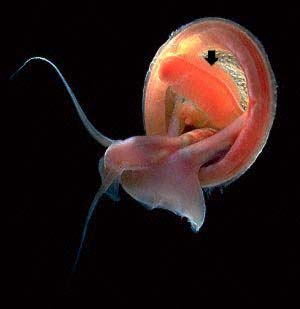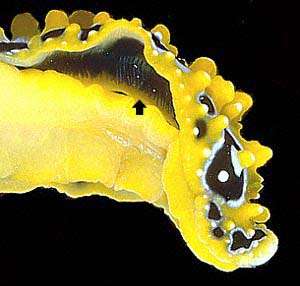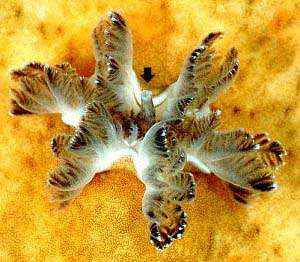
Torsion and detorsion
PHOTO
UPPER: The primitive marine snail Phenacolepas, with its cap-shaped shell folded back to show its mantle cavity. Note pair of large shell muscles and single large gill (arrow).
LOWER RIGHT: Gills of the dorid nudibranch Platydoris showing the anal papillae (arrow) intimately connected.
LOWER LEFT: Part of the left side of the phyllidiid Phyllidia ocellata showing the secondary gills (arrow).
PHOTOS: Bill Rudman.
RELATED TOPIC
Detorsion - how snails became sea slugs
The evolution of the opisthobranch body plan is basically a story of how these animals "detorted”. And to understand what that means we need to know what “torsion” is. In simple terms, the primitive gastropod snail has twisted its body so that the posterior end, with the anus, reproductive openings, kidney openings and gills, comes to sit above the head facing forwards. Why this occurred has been debated for over a century. Clearly it is related to the evolution of a shell with only a single “mouth” or opening, but which came first is still being debated. The photo of Phenacolepas, a relatively primitive marine snail, with a cap-shaped shell, illustrates the main features of a “torted” mollusc. The mantle cavity, enclosed by the shell sits above the head, and faces forwards, as do the anus and all the other openings situated in the mantle cavity. Torsion, or twisting, often lead to an assymetry in the mantle cavity organs, the loss of one of a set of paired gills being one of the most obvious examples. In Phenacolepas, only one gill remains.
The story of opisthobranch evolution is essentially the history of detorsion and the loss of the shell. In the cephalaspid Bubble Shells and the aplysiid Sea Hares there are many examples showing the gradual reduction in the size and importance of the shell, and the gradual rotation backwards, down the right hand side, of the mantle cavity opening and its associated organs - the gill, anus, reproductive openings etc. Another group of sea slugs, the notaspideans (pleurobranchs etc), are also called the “side-gilled” slugs because their gills stopped on the right side of the body during their evolution. The photo of Berthella martensi with an autotomised mantle skirt shows the gill on the right side of the body. Even in the true nudibranchs, which no longer have a shell or a mantle cavity, the close relationship of these former mantle cavity structures can be seen in the inseparable partnership between the anal papillae and the dorid gill circlet as seen in Platydoris.
Some gills in nudibranchs are clearly not the original gills but are secondary structures. In Phyllidia there are secondary gills along each side of the body between the mantle edge and the foot. In aeolids and tritoniids the original gill is lost and secondary papillae or cerata have evolved to take their place.
LOWER RIGHT: Gills of the dorid nudibranch Platydoris showing the anal papillae (arrow) intimately connected.
LOWER LEFT: Part of the left side of the phyllidiid Phyllidia ocellata showing the secondary gills (arrow).
PHOTOS: Bill Rudman.


Rudman, W.B., 1998 (October 28) Torsion and detorsion. [In] Sea Slug Forum. Australian Museum, Sydney. Available from http://www.seaslugforum.net/find/torsion
Related messages
Gastropod torsion
March 19, 1999
From: Manjit Hansra
Hello....
I saw the page you had on the nudibranch torsion of gills, but was wondering if you had any additional information on gastropod torsion in general. Any additional discussion upon its evolutionary history and variety of opinions for its existence would be very helpful.
Thank-you for your time,
Manjit Hansra
manjit_hansra@hotmail.com
Hansra, M., 1999 (Mar 19) Gastropod torsion. [Message in] Sea Slug Forum. Australian Museum, Sydney. Available from http://www.seaslugforum.net/find/690Dear Manjit,
I am afraid an account on gastropod torsion in general, although very interesting, is a bit outside the scope of the Forum. If I had the time I would love to answer general mollusc questions but I don't. I have mentioned a number of times a new 2 volume book on molluscs which was published last year in Australia called Mollusca: The Southern Synthesis. Despite its name, it covers all the mollusc families worldwide and has introductory chapters on all aspects of mollusc evolution. Unfortunately it is a bit expensive but all good libraries should be urged to get a copy.
If you are interested there is a description of the book on Dave Behrens, Sea Challengers online bookshop at http://www.seachallengers.com/ (California) and at Patty Jansen's Capricornia Publications at http://www.capricornica.com/ (Sydney, Australia).
Two useful recent references would be:
Haszprunar, G. (1988). On the origin and evolution of major gastropod groups, with special reference to the Streptoneura (Mollusca). Journal of Moulluscan Studies, 54: 367-441.
Ponder, W.F. & Lindbergh, D.R. (1997) Towards a phylogeny of gastropod molluscs. Zoological Journal of the Linnean Society, London, 19(2): 83-265.
Best wishes,
Bill Rudman.
Torsion & nudibranch gills
October 28, 1998
From: Hilda Norris
I was wondering if you had any information on gill torsion of nudibranchs or if you knew of any books that explain the evolutionary process of it well.
In particular I was just wondering if you knew of how the nudibranchs had evolved external gills.
Thank you for your time.
Hilda Norris
h_norris@hotmail.com
Hilda Norris, 1998 (Oct 28) Torsion & nudibranch gills. [Message in] Sea Slug Forum. Australian Museum, Sydney. Available from http://www.seaslugforum.net/find/274Dear Hilda,
Have a look at the top of the page for some information on detorsion in sea slugs. It's not really how the nudibranchs evolved external gills, but how they lost their shell. One of the jobs of the mollusc shell is to protect the gills. Once the shell has gone, the gills have no choice - they are nude! Which is where the word NUDIBRANCH (naked gill) comes from.
I have realised in the last couple of weeks that I need to add some more of the primitive sea slugs (cephalaspids in particular) to the Sea Slug Forum so the evolution of the group can be better illustrated. If you can be patient I will add some more examples over the next few weeks.
About good books on "torsion". It really depends on how deep you want to explore. Most good invertebrate text books have a general account of the process. For a fuller review you would need to have a look at a specialised mollusc text. Check out your local university library and see what they have. If you have no luck let me know and I'll look out a couple of useful references. ... Bill Rudman.
Rudman, W.B., 1998 (Oct 28). Comment on Torsion & nudibranch gills by Hilda Norris. [Message in] Sea Slug Forum. Australian Museum, Sydney. Available from http://www.seaslugforum.net/find/274